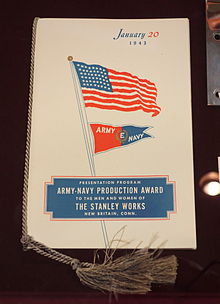Army-Navy "E" Award
The Army-Navy "E" Award was given to American companies during the Second World War for the production of armaments. The award is also known as the Army-Navy Production Award .
The award consisted of a pennant for the company and a badge for all employees who had worked in the company at the time the product in question was produced. The pennant showed a black and a red half with the inscription "NAVY" and "ARMY" respectively. An "E" was emblazoned in the middle, framed by a golden wreath of oak leaves.
Only 4% of American arms factories received the Army-Navy Award during the entire duration of the Second World War. After the end of the war, the Army-Navy Award program ended.
An officer from the Army and one from the Navy were usually present at the ceremony. All employees of the company were gathered for the handover. After the general award ceremony, each employee received the badge individually. A total of 4,283 companies received the award during the war. Around half went to companies with fewer than 500 employees. Companies whose excellent work continued received additional stars on their pennants. Some companies received up to 6 stars.
history
As early as 1906, Theodore Roosevelt launched the so-called Navy “E” Award, with the “E” standing for excellence. Initially, the award was only given to producers of guns, while later generally all armaments that fell into the military sector of the Navy were recognized. Due to the state of war between the United States and the Axis powers, attempts were made to create a new incentive to produce armaments by launching the Army-Navy E Award in July 1942. For this purpose, the Navy E Award, the Army A Award and the Army-Navy Munitions Board Award have been combined into a new award, the Army-Navy E Award.
All American arms companies were able to receive this award. Although the award was more aimed at the industry, an academic institution and a single person also received the award. Iowa State College (now Iowa State University ) received the award for its contribution to uranium production for the Manhattan Project , while Harley A. Wilhelm received the award for inventing the Ames process for the extraction, processing and mass production of uranium. Harley A. Wilhelm's work took place at Iowa State College .
Some of the selection criteria for the Army-Navy Award were:
- Quality and quantity of production
- Overcoming production hurdles
- Avoidance of production stops
- Compliance with the fair labor standards
- Effective management
- Keeping records of accidents, health, sanitation and company security
Nominations for the award were given by the Technical Service of the Army Service Forces, the Air Force , the Navy Department, the Coast Guard or the Marine Corps , depending on which part of the armed forces benefited most from the goods produced.
These nominations went to the Army Board for Production Awards, while nominations from among the Navy went to the Navy Board for Production Awards. Before the award was given, the respective other institution had to agree.
Firms that continued to perform received an additional white star on their flag after a 6 month period. A total of 4 additional stars could be awarded according to this procedure. Then the interval for a new star was increased to 1 year. Of the 4,283 companies that received the award, 8 companies managed to receive 6 stars. 763 companies received an award with one star, 723 companies received 2 stars, 776 companies received 3 stars, 820 companies received 4 stars and 206 companies received 5 stars. The last award was presented at a meeting of the Army and Navy Boards for Production Awards in August 1945. The two bodies were then dissolved.
End of the program
On December 5, 1945, the Army Navy “E” Award program ended.
After the end of the Second World War there was no longer any massive need for armaments. The right to wear the award in the form of the awarded flag or badge did not end there, just as little as to advertise yourself with the help of the award won.
Individual evidence
- ↑ The Army-Navy “E” Award - World War 2 - industrialhistory.org, accessed May 15, 2016
- ↑ a b c d e f g h i Army-Navy "E" Award Termination & Award Winners - New Mexico and New York - wikimedia.org, accessed May 15, 2016
- ^ Army Navy E Award - randomneatstuff.blogspot.de, accessed May 15, 2016

